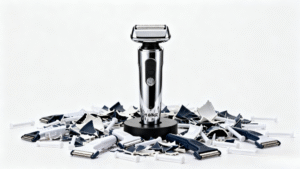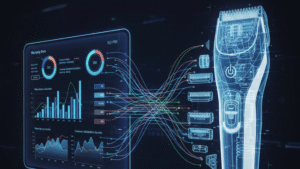Imagine this scenario: your first shipment of 10,000 brand-new body groomers arrives at your warehouse. Excitement turns to horror as you discover that 5% of the units have minor scratches and molding imperfections—small flaws, but enough to make them unsellable at full price. This is a brand’s nightmare, a direct result of gaps in quality control.
Robust Quality Control in Groomer Manufacturing is the single most important process for protecting your investment and your brand’s reputation. While traditional methods have served the industry for decades, they have limitations. This guide will explore the essential pillars of a modern QC process and then reveal how a powerful new trend—AI visual inspection—is taking quality assurance to an unprecedented new level, ensuring the product your customer unboxes is perfect, every time.
The Foundation: The Three Pillars of Traditional QC
Any reputable manufacturer’s quality process is built on three distinct stages. Understanding these is crucial when you vetting suppliers.
- IQC (Incoming Quality Control): This happens before mass production begins. It is the inspection of all raw materials and components that arrive at the factory. For a body groomer, this means testing batches of batteries for capacity, checking motors for consistent RPM, and ensuring the plastic housing matches your exact Pantone color. Strong IQC prevents faulty components from ever entering the assembly line.
- IPQC (In-Process Quality Control): This is the monitoring that happens during assembly. QC staff patrol the production line, checking key steps—like the torque on screws, the integrity of waterproof seals, and the correct placement of parts. IPQC aims to catch errors as they happen, preventing the creation of thousands of defective units.
- FQC (Final Quality Control): This happens after the product is fully assembled but before it’s packaged. Inspectors take a random sample of the finished goods (based on AQL standards) and conduct a full battery of tests: function, safety, and, most importantly, a visual check for cosmetic defects.

The Limitation of the Human Eye
While essential, the FQC stage has a major vulnerability: it relies on human inspection. For a product where aesthetic perfection is key, this presents several challenges:
- Subtlety: Tiny scratches, slight color mismatches, or minor molding marks are incredibly difficult for the human eye to spot consistently over an 8-hour shift.
- Fatigue & Inconsistency: An inspector’s performance at 9 AM is not the same as at 4 PM. What one person considers a “minor” defect, another might fail. This subjectivity leads to inconsistent quality.
- Scale & Speed: In a high-speed production line, it’s impossible for humans to inspect 100% of the cosmetic features on every single unit. This is why sampling is used, but it statistically guarantees that some defective units will be shipped.

The Revolution: How AI-Powered Visual Inspection Works
This is where your title’s core technology comes in. AI visual inspection is a revolutionary step in automated quality control. It’s like giving your production line superhuman eyes that never get tired.
The process is simple in concept but powerful in execution: a high-resolution camera is placed on the assembly line and takes a picture of every single product. A highly trained Machine Learning (ML) model then instantly compares that picture to a “golden sample” (a perfect reference product). In milliseconds, it can spot dozens of types of flaws with incredible accuracy.
This defect detection with AI can identify:
- Surface Defects: Scratches, dents, smudges, dust, or air bubbles.
- Color Deviations: Mismatches in color that are almost imperceptible to the human eye.
- Printing & Logo Errors: Faded logos, incorrect symbols, or misaligned text.
- Assembly Errors: Gaps between parts, misaligned components, or even missing screws.
This technology is a cornerstone of the smart factory and Industry 4.0, moving quality control from a reactive, sample-based process to a proactive, 100% inspection model.

The Benefits of AI in Your QC Process
Integrating AI in quality control provides tangible business benefits that far outweigh the initial investment.
| Metric | Manual Visual Inspection | AI-Powered Visual Inspection |
| Accuracy & Consistency | Variable, subject to human error and fatigue. | Extremely High, over 99.9%. Consistent 24/7. |
| Speed | Slow, inspects a few units per minute. | Extremely Fast, inspects multiple units per second. |
| Inspection Scope | Typically a sample (AQL). | Can inspect 100% of units on the line. |
| Data Collection | Manual records, limited insights. | Rich data on every defect, enabling root cause analysis. |
| Long-Term Cost | Ongoing labor costs. | Initial setup cost, but lower long-term operational cost. |
How to Implement AI Visual Inspection in Your Supply Chain
As a brand, you can start leveraging this technology to improve your product quality.
- Start the Conversation with Your Supplier: The first step is to ask your manufacturing partner if they have, or are planning to implement, automated quality control systems. A factory’s investment in this technology is a powerful indicator of their commitment to being a top-tier manufacturer. This should be a key question in your next factory audit.
- Focus on Critical Components First: You don’t need to automate everything at once. Start with the most important cosmetic part, like the main product housing where your logo is printed. This is where visual perfection matters most.
- Understand Their Technology Partner: Many factories work with third-party AI solution providers. Ask who their provider is and inquire about their expertise in the consumer electronics space.

Conclusion: From Manual Art to Data-Driven Science
Robust Quality Control in Groomer Manufacturing is the bedrock of a successful hardware brand. While the traditional pillars of IQC, IPQC, and FQC provide a necessary foundation, the future of quality assurance is undeniably in automation and artificial intelligence.
AI visual inspection is transforming Quality Assurance (QA) from a subjective, manual art into a precise, data-driven science. By enabling 100% inspection at high speed, it drastically reduces the Defect Rate, enhances Manufacturing Efficiency, and ensures that the product your customer unboxes is a perfect representation of your brand’s promise, every single time.





